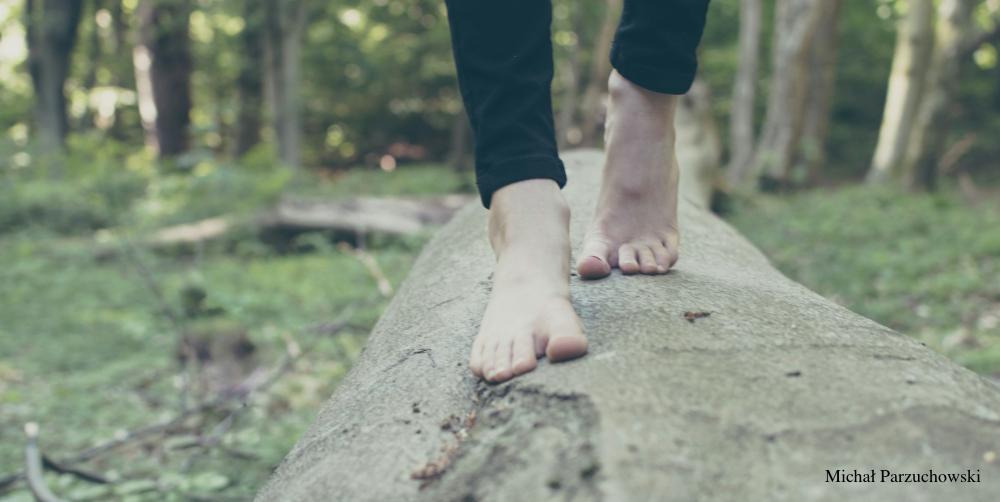
When you are preparing for or recovering from total hip replacement surgery you need increased stability to support your new joint. The whole-body benefits of an asana practice begin with the feet, and the way you connect with the earth will have a ripple effect throughout your body. Bare feet provide the most possible stability and the benefits of bare feet are many.
Typically yoga is practiced in bare feet. Bare feet have the freedom to move and flex and they give you direct contact with the floor. Doing yoga with bare feet provides an opportunity to stretch and strengthen all the muscles in the feet. In addition, the feet represent a focal point of energy that connects throughout the body. As your feet become more nimble and strong, your whole body will benefit, including your hips!
Benefits of Bare Feet: Stability and Balance
The way your feet connect with the floor affects the stability of the whole body. A solid connection starts with active arches and with all “four” points of the foot making contact with the floor. This kind of action in the foot is called Pada Bandha.
How to practice Pada Bandha
- Start in Mountain Pose.
- Balance your weight over your feet.
- Lift and spread your toes wide apart and while keeping them spread, try to elongate them as you lower each toe one by one, starting with the little toe. This will activate the muscles and arches of the feet. Notice how your arches rise.
- Press down though the root of the big and little toe and press down through the inner and outer heal.
- With the foot activated feel the springiness in your stance.
- Notice sensations in the rest of your body — legs, pelvic floor, belly, chest, arms, hands …
- Breathe and observe.
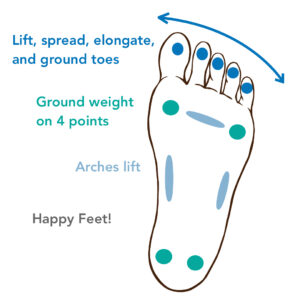
Additional Benefits of Bare Feet
Pada Bandha also stimulates the flow of energy in the body and has the effect of recruiting the other bandhas (mula bandha, uddiyana bandha, jalandhara bandha, and hasta banda).
Pada Bandha strengthens the feet by actively engaging the muscles of the feet.
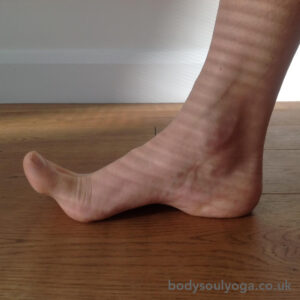
Use your bare feet to take advantage of the Earth’s energy. Research has shown that the Earth’s electrons can induce multiple positive physiological effects, including reduced pain, better sleep, a shift from sympathetic to parasympathetic tone in the autonomic nervous system (ANS), and a blood-thinning effect. Try walking barefoot on the beach, in the park, or on your lawn. Or, lie in the grass under a tree.

Strengthen, Stretch, and Reap the Benefits of Bare Feet.
- Stand in Tadasana and lift and spread your toes then place each toe down on the floor one and a time, starting with the little toe. This not only strengthens muscles that support the arches of the feet, it also challenges toe coordination.
- Stand in Tadasana with Pada Bandha activated. Shift your body weight forward so that you begin to rise up on to the balls of your feet. Lift and lower several times. This strengthens the feet muscles and the calf muscles.
- Stretch the tops of your feet by kneeling on the floor in Virasana.
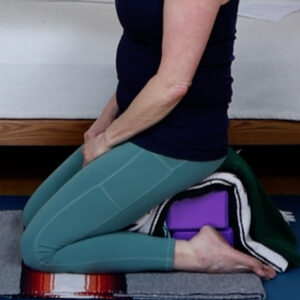
4. Stretch the bottoms of your feet in a high lunge with the back toes turned under or by kneeling with the toes turned under
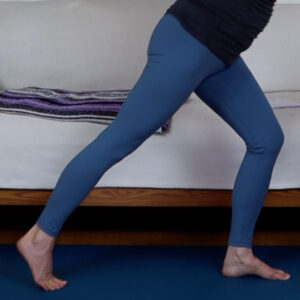
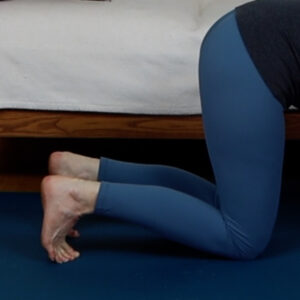
In the end, if you have a regular and varied yoga practice your feet will be in good shape and they will serve you well as you move through total hip replacement.
A note about shoes:
If you cannot tolerate bare feet and if you choose to wear shoes, pick a pair that you dedicate to only your yoga practice. You want to keep your mat as clean as possible to respect your health.
Choose shoes that give you the comfort you need but that also are flexible so that they can bend with the movements of your feet. Choose shoes that fit so that the soles of your feet do not slide around.
Finally, get inventive! Tune in to your feet when you are walking, standing, dancing… to find ways to stretch, strengthen, and pamper them. Dedicate a yoga practice to your feet!
Here’s to Healthy and Happy Hips!
Key Takeaways: The Benefits of Bare Feet
- Enhanced Stability & Balance – Practicing yoga barefoot strengthens foot muscles, improves balance, and supports the stability needed for post-hip replacement recovery.
- Activation of Pada Bandha – Engaging the foot’s arches through Pada Bandha improves posture, alignment, and energy flow throughout the body, benefiting the hips and beyond.
- Strength & Flexibility – Yoga poses like Mountain Pose, Tadasana, and Virasana help stretch and strengthen the feet, reducing strain on the hips.
- Connection to Earth’s Energy – Walking barefoot can reduce pain, improve sleep, and enhance circulation, contributing to overall well-being.
- Shoe Considerations – If barefoot practice is not an option, choose flexible, well-fitting shoes dedicated solely to yoga to maintain grip and stability.
Frequently Asked Questions:
- Why is practicing yoga barefoot beneficial after hip replacement surgery?
Practicing yoga barefoot enhances stability, strengthens foot muscles, and improves balance, which is essential for supporting your new hip joint. Bare feet also help you connect better with the ground, providing a strong foundation for movement. - What is Pada Bandha, and how does it help with stability?
Pada Bandha is a technique that activates the arches of the feet by pressing down through four key points. This strengthens the feet, promotes better alignment, and improves overall stability important for those recovering from hip replacement. - Can barefoot yoga improve my hip mobility and strength?
Yes! Strengthening and stretching the feet in yoga contributes to better posture and alignment, which helps reduce strain on the hips and improves overall mobility. - What if I can’t practice yoga barefoot due to foot discomfort?
If barefoot practice is uncomfortable, choose yoga-specific shoes that are flexible and supportive. This allows for movement while still maintaining some foot engagement with the ground. - How does walking barefoot support healing after hip surgery?
Walking barefoot especially on natural surfaces like grass or sand can help stimulate circulation, reduce inflammation, and improve nervous system function, all of which support recovery. - What are some easy yoga exercises I can do to strengthen my feet?
You can start with:
Toe lifts: Spread your toes wide and place them down one at a time.
Heel raises: Rise onto the balls of your feet and lower back down.
Foot stretches: Try kneeling in Virasana or lunging with the back toes turned under. - Can foot exercises really improve my balance and prevent falls?
Absolutely! Strong, engaged feet create a solid foundation, reducing the risk of misalignment and falls especially important when recovering from hip replacement. - How does grounding (earthing) benefit my recovery?
Grounding, or direct contact with the earth, has been linked to reduced pain, improved sleep, and enhanced nervous system function, all of which aid in recovery. - Should I dedicate a yoga session specifically to my feet?
Yes! A regular practice focusing on foot strength and flexibility can improve overall movement, stability, and comfort—making daily activities easier after hip replacement.
Member Videos: Mountain Pose / Tadasana, Sitting in a Kneeling Position / Virasana, Downward Facing Dog / Adho Mukha Svanasana
Non-Member Preview: Yoga Basics, Standing Poses
Free video: Yoga while healing from Total Hip Replacement Surgery: A safe post-op asana practice
Become a member of Yoga for Hip Replacement here
Articles and Studies:
Earthing: Health Implications of Reconnecting the Human Body to the Earth’s Surface Electrons
The Importance of the Feet in Yoga—On and Off the Mat
“Muscle strength, pain and disability in patients with osteoarthritis”
